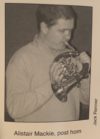The three-valved post horn in B-flat used on this recording (pictured below) was found in a shop in Vienna and is an exact replica of an instrument in the Austrian Musical Instrument Museum that would have been in use at the time of the symphony’s composition.
In the autograph score of 1896 Mahler‘s word “trumpet” is scratched out by the composer and the word Flugelhorn is clearly legible. “Der Postillon” (mailcoach driver) and “wie die Weise eines Posthorns” (in the manner of a post horn) appear above the solo. The first edition indicated Flugelhorn for the solo, but all later additions call for the Post horn. So, it appears that at some point in between, Mahler changed his mind. I am not aware of any other recording that fulfills Mahler’s specific wish that it be played on this tiny, famously intractable instrument.
The strange-sounding glissandi in the oboe and English horn in the fourth movement were intended by Mahler to suggest the “call of the night bird.” Mahler knew that it was not possible to do a slide on an oboe, much less an English horn, but probably wanted the illusion of a slide to evoke in Erie, hunting call to help conjure the emotional feel of midnight in a vast and forlorn landscape. The modern English horn (or cor anglais) had to be modified by removing some keys and inserting putty and two of the holes. My gratitude to Ron Kaye, English horn player of the Boston Philharmonic, for preparing the instrument. Also, to two ornithologist friends, Robert and Dana Fox, who researched the actual calls of birds and native to Austria to see if there was any way of determining whether Mahler had the call of a specific bird in mind. Their best guess is the Eurasian Curlew (numenius arquata).
The boys’ choir, intended by Mahler to be placed high up and in the distance, was recorded from a position in the balcony behind me as I conducted, and approximately 200 feet from the women’s choir which was placed behind the orchestra.
